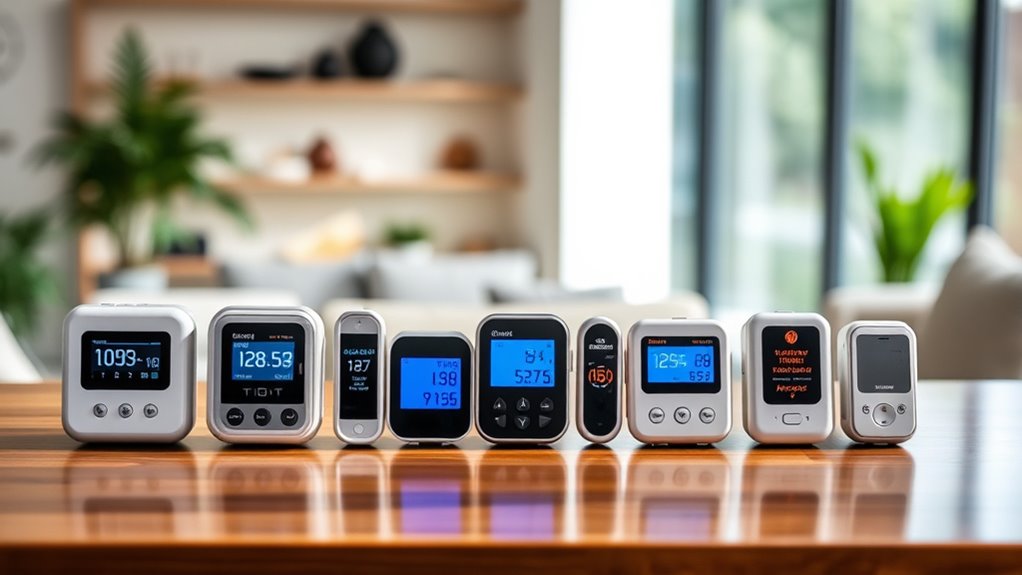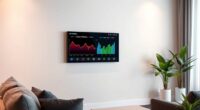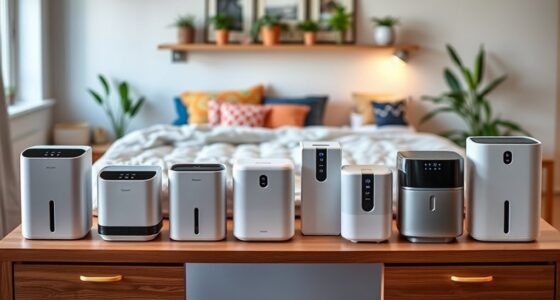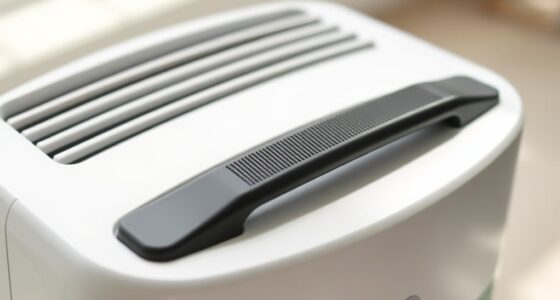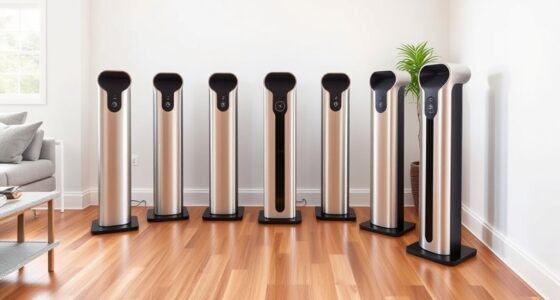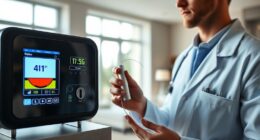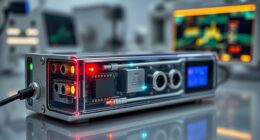If you’re looking for the 13 best formaldehyde detectors for home use in 2025, I recommend options that combine high accuracy, multi-parameter detection, and smart features like Wi-Fi connectivity and real-time alerts. Many models are portable, rechargeable, and easy to operate, helping you keep indoor air safe from pollutants like formaldehyde, TVOCs, and PMs. Stay tuned—I’ll share insights on top devices that fit your needs and how to choose the best one.
Key Takeaways
- Look for devices with multi-parameter detection, including formaldehyde, TVOCs, and particulate matter, for comprehensive indoor air quality monitoring.
- Prioritize models with real-time data display, trend analysis, and visual or sound alarms for immediate pollution alerts.
- Choose portable, rechargeable detectors offering long battery life and Wi-Fi or app connectivity for remote monitoring and data logging.
- Consider calibration requirements and sensor lifespan to ensure sustained accuracy over time.
- Review user-friendly interfaces and durability features suitable for home environments and various indoor activities.
Indoor Air Quality Monitor (8-in-1 Formaldehyde & VOC Detector)
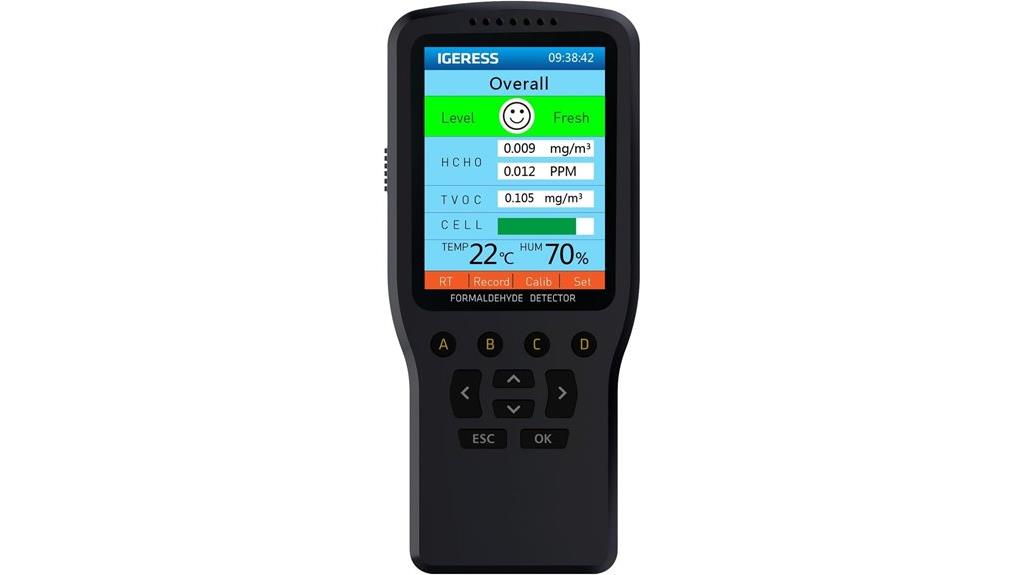
If you’re looking for a reliable way to monitor your home’s air quality, the Indoor Air Quality Monitor (8-in-1 Formaldehyde & VOC Detector) is an excellent choice. It measures formaldehyde, TVOCs, particulate matter, temperature, and humidity with high accuracy, thanks to advanced sensors and an AD smart chip. The colorful LCD display shows real-time data, health indicators, and trend curves, while audible alarms alert you when levels are unsafe. Its portable design, rechargeable battery, and one-button operation make it easy to use anywhere. Whether at home, in the office, or during activities like painting or printing, this device helps you maintain a healthier indoor environment effortlessly.
Best For: homeowners, office workers, and activity enthusiasts seeking real-time, comprehensive indoor air quality monitoring for healthier living and working environments.
Pros:
- Accurate detection of formaldehyde, TVOC, particulate matter, temperature, and humidity with advanced sensors and smart chip
- User-friendly with a large LCD display, audible alarms, and portable rechargeable design for easy use anywhere
- Provides real-time data, trend curves, and health indicators to help users quickly assess air quality conditions
Cons:
- Calibration can be time-consuming and requires outdoor procedures, which may inconvenience some users
- Limited alarm customization, only triggering for formaldehyde, restricting tailored alerts for other pollutants
- Some users report variability in readings and emphasize understanding environmental factors for accurate interpretation
Air Quality Pollution Monitor and Tester
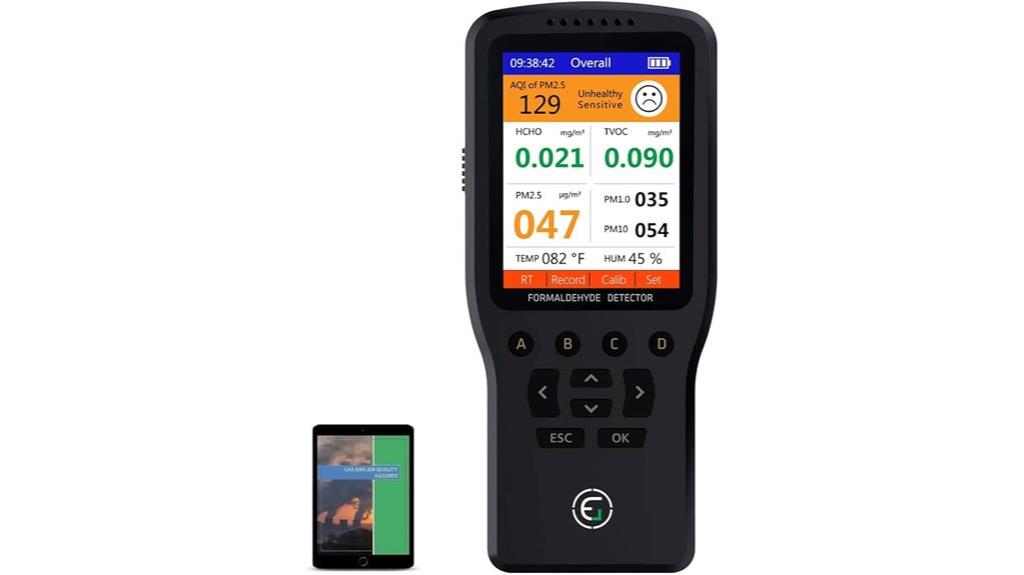
The Air Quality Pollution Monitor and Tester stands out as an ideal tool for health-conscious homeowners who want real-time insights into indoor air quality. It accurately measures temperature, humidity, formaldehyde, VOCs, and particulate matter like PM2.5. Equipped with advanced sensors, a built-in fan, and laser dust sensors, it provides instant readings on a clear LCD screen. Its portable design runs on a rechargeable battery, making it perfect for indoor and outdoor use, especially in wildfire zones or homes with new furniture. This device helps identify hidden hazards, verify air purifier performance, and monitor pollution levels, empowering you to make healthier choices effortlessly.
Best For: health-conscious homeowners, allergy sufferers, and individuals needing real-time indoor and outdoor air quality monitoring.
Pros:
- Provides accurate, real-time measurements of formaldehyde, VOCs, particulate matter, temperature, and humidity.
- Portable and rechargeable design suitable for indoor and outdoor use, including wildfire-prone areas.
- User-friendly with a clear LCD display, audible alarms, and straightforward controls.
Cons:
- Requires proper calibration outdoors in fresh air for optimal accuracy.
- Does not store historical data or calibration settings across power cycles.
- Some users find the device’s plastic construction and battery life to be limited or less durable.
Indoor Air Quality Monitor (AQI Meter for PM2.5 and VOC)

Indoor air quality monitors with AQI meters for PM2.5 and VOCs are ideal for homeowners who want continuous, real-time insights into their indoor environment. These devices track pollutants like formaldehyde, fine particles, and kitchen fumes using advanced sensors, providing accurate data on air quality, humidity, and temperature. They feature laser-based sensors for visible pollution sources and employ smart algorithms for precise readings. With calibration technology that adjusts for temperature differences, they guarantee reliable results. An integrated hazard alarm alerts me if pollution levels become unsafe, helping me take immediate action to maintain a healthy living space.
Best For: homeowners, parents, and office managers seeking real-time, accurate indoor air quality monitoring to ensure a healthy living and working environment.
Pros:
- Provides 24-hour real-time detection of pollutants like formaldehyde, PM2.5, VOCs, humidity, and temperature for comprehensive air quality insights.
- Utilizes advanced laser-based sensors and intelligent algorithms for precise and visible pollution source detection.
- Features an intelligent hazard alarm system that alerts users immediately when pollution exceeds safe levels.
Cons:
- May require periodic calibration to maintain measurement accuracy, especially in changing environmental conditions.
- Could be more expensive than basic air quality monitors due to its advanced sensors and technology.
- The device’s complexity might necessitate some user familiarity with air quality metrics for optimal operation.
Air Quality Monitor, Professional Air Quality Detector
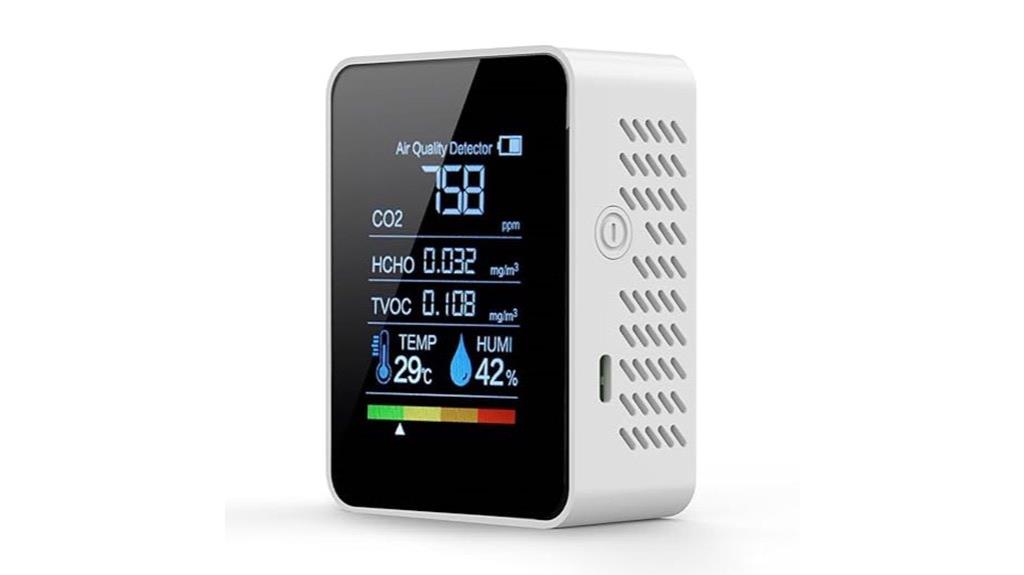
A professional air quality detector stands out for its ability to provide real-time, thorough data on multiple airborne pollutants, making it ideal for those who need accurate and immediate insights into their environment. I’ve used this 5-in-1 device to monitor CO2, formaldehyde, VOCs, temperature, and humidity, offering a comprehensive picture of indoor air quality. Its bright display and simple setup via USB-C make it user-friendly. With a portable design and up to 20 hours of battery life, I can easily move it between rooms or take it outdoors. The high-precision sensors deliver reliable data, helping me promptly address poor air quality and maintain a healthier environment.
Best For: individuals seeking real-time, comprehensive indoor air quality monitoring for homes, offices, or outdoor environments.
Pros:
- Provides accurate, real-time data on CO2, HCHO, TVOC, temperature, and humidity.
- Compact, portable design with up to 20 hours of battery life for versatile use.
- User-friendly interface with a bright display and easy setup via USB-C.
Cons:
- Battery life may be shorter than advertised, with some users experiencing only a few hours of use.
- Charging cable quality and management can be challenging.
- Lacks trend analysis features through an app, limiting long-term data tracking.
CO2 Indoor Air Quality Monitor (White)
https://m.media-amazon.com/images/I/61tW2XjkE3L._AC_SX679_.jpg
Looking for a versatile device that keeps your indoor air safe while providing real-time data? The CO2 Indoor Air Quality Monitor (White) is a 5-in-1 gadget that measures CO2, formaldehyde, TVOC, temperature, and humidity. Its portable design, lightweight build, and rechargeable battery make it perfect for homes, offices, or travel. The bright color screen shows instant readings, and alarms alert me when levels are unsafe. While its accuracy is impressive, some users report fluctuating CO2 measurements and calibration challenges. Still, it’s a handy tool for monitoring indoor air quality, especially when combined with other air purification methods.
Best For: individuals seeking a portable all-in-one indoor air quality monitor to track gases and environmental conditions in homes, offices, or while traveling.
Pros:
- Offers real-time measurements of CO2, formaldehyde, TVOC, temperature, and humidity in a single device.
- Features a bright, easy-to-read color display with auto-calibration and audible/vibrating alarms for quick alerts.
- Rechargeable battery provides over 24 hours of portable use, making it convenient for various locations.
Cons:
- Some users experience fluctuating CO2 readings and calibration difficulties over time.
- Bright LED screen can be too luminous at night, with no option to turn off the display.
- Battery life may require daily recharging, and charging compatibility can be limited with certain USB-C cables or ports.
Indoor Air Quality Monitor with LCD Screen & USB Charging

If you’re seeking a portable and user-friendly way to monitor your home’s air quality, the Indoor Air Quality Monitor with LCD Screen and USB charging is an excellent choice. It detects formaldehyde, TVOC, PM2.5, PM10, temperature, and humidity, offering real-time readings on a clear 7-inch LCD display. Equipped with visual and sound alarms, it alerts you when air safety levels are exceeded. Powered by batteries and supporting USB charging, it’s convenient for home use. The device uses high-accuracy electrochemical sensors, but calibration is essential for reliable results. Its straightforward operation makes it ideal for monitoring pollution sources like smoke, chemicals, or dust, promoting healthier living environments.
Best For: households and individuals seeking an easy-to-use, portable indoor air quality monitor to detect pollutants and maintain a healthier living environment.
Pros:
- Provides real-time readings of formaldehyde, TVOC, PM2.5, PM10, temperature, and humidity on a clear LCD display.
- Equipped with visual and sound alarms to alert users when air quality exceeds safe levels.
- Supports USB charging and runs on batteries, offering portability and convenience for home use.
Cons:
- Slight delay of about 15 seconds for real-time results.
- Build quality may feel cheap, and data logging resets when navigating away from the data screen.
- Temperature is displayed only in Celsius, not Fahrenheit, which may be less convenient for some users.
Air Formaldehyde (HCHO) DIY Test Kit
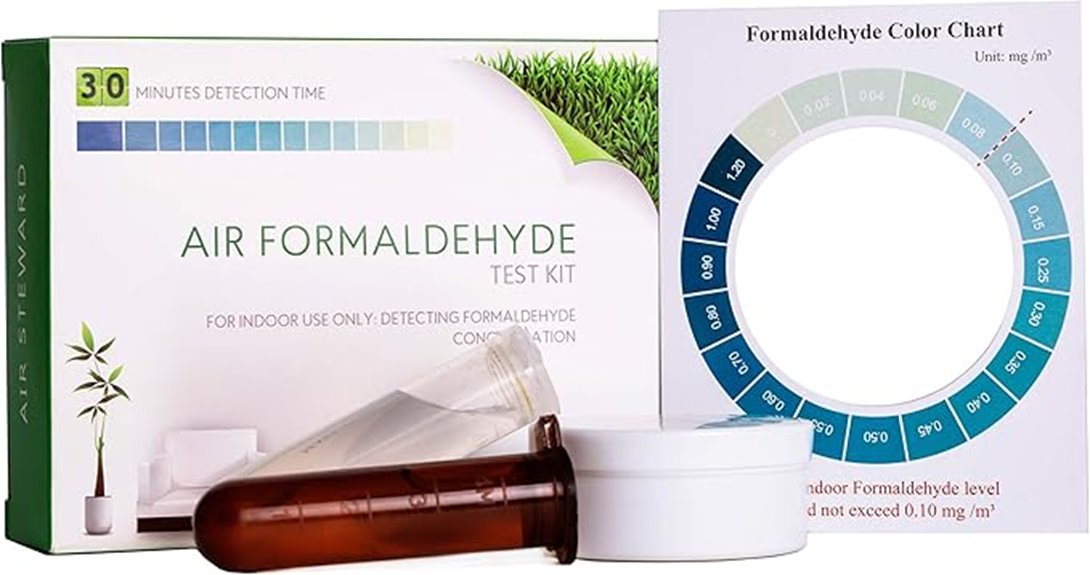
Homeowners seeking quick and reliable detection of formaldehyde in indoor air will find the Air Formaldehyde (HCHO) DIY test kit an ideal choice. This kit is designed for spaces up to 270 square feet, so use one per room for thorough testing. The process involves a simple six-step manual, requiring you to turn off ventilation and air purifiers at least 8 hours before testing. Results appear visually within 30-50 minutes, making it quick and straightforward. The kit includes essential components like an absorption box, colorimetric card, and user manual, helping you identify formaldehyde levels easily and safely in your home environment.
Best For: homeowners and indoor space users seeking a quick, reliable, and easy way to detect formaldehyde levels in rooms up to 270 square feet.
Pros:
- Provides visual results within 30-50 minutes for prompt assessment.
- Simple six-step manual makes testing straightforward for non-professionals.
- Includes all necessary components and clear instructions for safe use.
Cons:
- Only suitable for indoor environments; not applicable for outdoor air testing.
- Results may be difficult to interpret at very low formaldehyde levels.
- Requires turning off ventilation and air purifiers at least 8 hours prior, which may not be convenient for immediate testing.
8-in-1 Indoor Air Quality Monitor
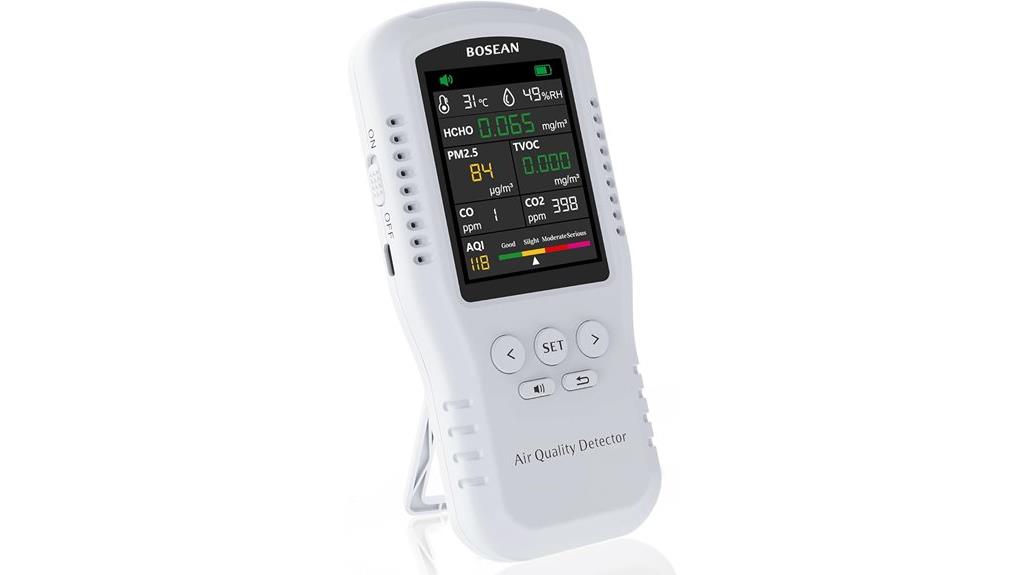
The in-1 Indoor Air Quality Monitor is an ideal choice for those who want all-encompassing, real-time insights into their indoor environment. It measures eight data types, including formaldehyde, CO, CO2, AQI, TVOC, PM2.5, temperature, and humidity, giving you a thorough view of indoor air quality. Its user-friendly LCD color screen clearly indicates pollution levels, while simple operation makes it accessible for everyone. The device’s built-in memory records the last 8 hours of data, and alarms alert you when safety thresholds are exceeded. With a rechargeable battery lasting up to 8 hours, it’s perfect for home, office, or travel use.
Best For: households, offices, and travelers seeking comprehensive real-time indoor air quality monitoring to ensure a healthy environment.
Pros:
- Measures 8 key air quality data types for thorough environmental assessment
- User-friendly LCD color screen with clear pollution level indicators
- Built-in memory records last 8 hours of data and supports voice alerts
Cons:
- Requires at least 1 hour of placement in a ventilated environment before use for accurate readings
- Battery life lasts only 6-8 hours, which may necessitate frequent recharging during extended use
- Designed solely for indoor use, limiting its effectiveness in outdoor environments
BREATHE Airmonitor Plus: Smart Indoor Air Quality Monitor
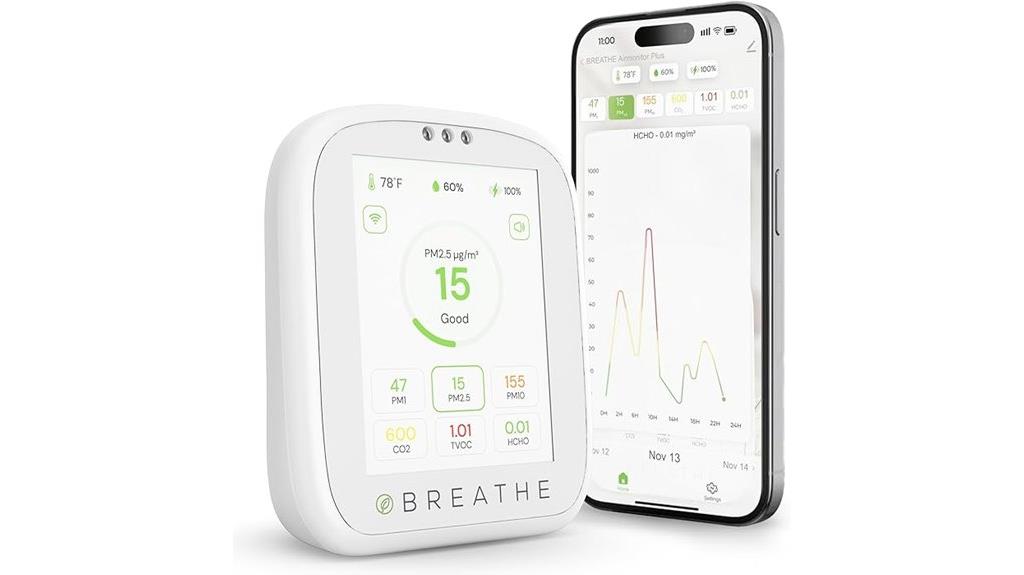
The BREATHE Airmonitor Plus stands out as an ideal choice for anyone seeking extensive indoor air quality tracking, especially when monitoring formaldehyde levels. I appreciate its 8-in-1 design, measuring particles, CO2, TVOC, temperature, and humidity, giving a thorough view of my home’s air. Its high-precision sensors ensure accurate real-time data, accessible via Wi-Fi through the Breathe Tech App. I can track trends, set alerts, and export data remotely. Its sleek, portable design makes testing multiple rooms easy. While battery life is limited to a few hours, the device’s ease of use and detailed insights make it a valuable tool for maintaining healthier indoor environments.
Best For: individuals seeking comprehensive and accurate indoor air quality monitoring, especially those concerned about formaldehyde, particulate matter, and ventilation health.
Pros:
- Provides 8-in-1 measurements for a complete indoor air quality assessment.
- High-precision sensors ensure reliable, real-time data.
- Wireless app connectivity allows remote monitoring, trend analysis, and data export.
Cons:
- Limited battery life (2-3 hours) restricts portability for extended use.
- Wi-Fi connectivity issues can affect consistent data access and device reliability.
- Lacks local data logging and Bluetooth setup options, which could enhance usability.
anlab™ Air Formaldehyde DIY Test Kit for Air Quality Testing
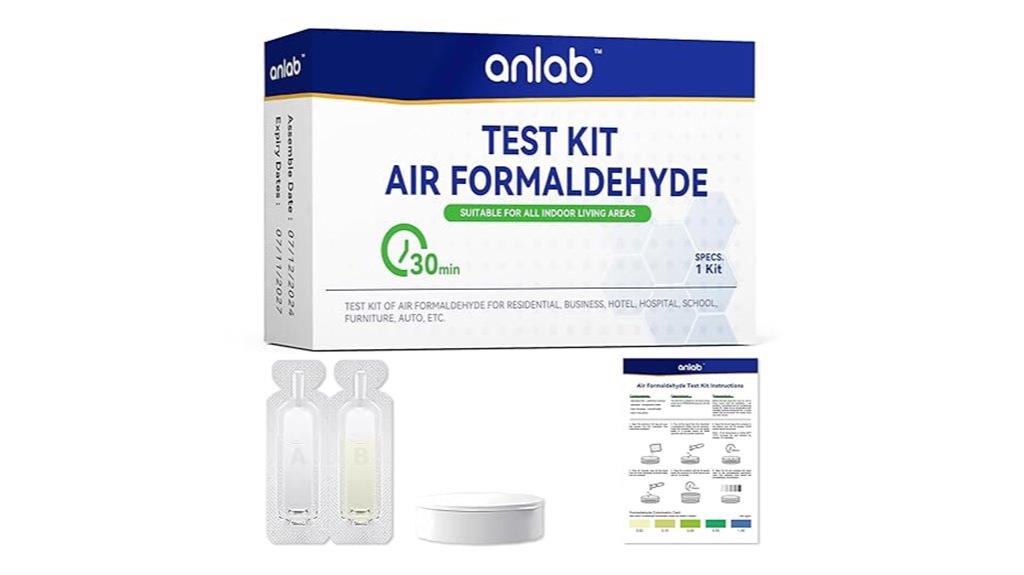
If you’re looking for a straightforward way to monitor indoor formaldehyde levels across different environments, the anlab™ Air Formaldehyde DIY Test Kit is an excellent choice. It’s designed for use in homes, offices, hotels, hospitals, schools, cars, and even furniture. The test involves a simple six-step process: you close the room, follow the instructions, and read the results promptly. While some users note slight variability, the kit reliably indicates if formaldehyde exceeds safety limits of 0.10 mg/m³. Most find it easy to use and helpful for peace of mind, especially when combined with proper ventilation or additional testing if needed.
Best For: individuals and property managers seeking an easy, at-home method to monitor indoor formaldehyde levels across various environments such as homes, offices, hotels, and vehicles.
Pros:
- Simple six-step testing process with clear instructions
- Provides quick results to help assess air safety levels
- Suitable for multiple environments including residential, commercial, and automotive spaces
Cons:
- Variability in readings may occur across different areas within the same space
- Less precise quantification of formaldehyde levels compared to digital tests
- Delivery delays reported by some users, with wait times up to four months
Formaldayhyde Detector with Vibration, Alarms, and Humidity Meter
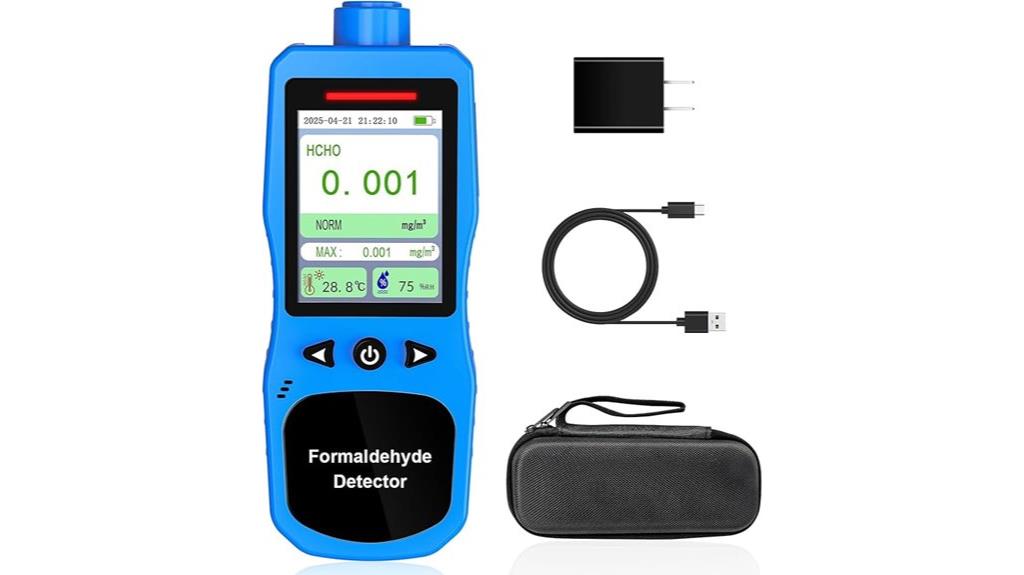
For homeowners concerned about maintaining a safe indoor environment, the Formaldayhyde Detector with vibration, alarms, and humidity meter offers an immediate, multi-sensory alert system that guarantees prompt responses to elevated formaldehyde levels. It provides high-precision detection with 0.001 mg/m³ accuracy and measures temperature and humidity, ensuring all-encompassing air quality monitoring. When levels exceed safety thresholds, it triggers a beeping sound, LED flashing, and vibration within half a second. Its compact, dust-proof design is portable and easy to use, making it suitable for homes, offices, or travel. With a long-lasting rechargeable battery, it keeps you informed and safe wherever you go.
Best For: homeowners, office workers, and travelers seeking real-time, accurate indoor air quality monitoring and immediate alerts for formaldehyde exposure.
Pros:
- High-precision detection with 0.001 mg/m³ accuracy ensures reliable readings.
- Multi-sensory alert system (sound, LED, vibration) provides quick warning of unsafe levels.
- Portable and lightweight design with long-lasting rechargeable battery facilitates use in various environments.
Cons:
- Limited measurement range (0-5 mg/m³) may not cover extremely high formaldehyde concentrations.
- Requires regular calibration or sensor replacement after 2 years to maintain accuracy.
- May be more expensive than basic air quality monitors due to advanced features.
Air Quality Monitor for Indoor Air Pollution Detection
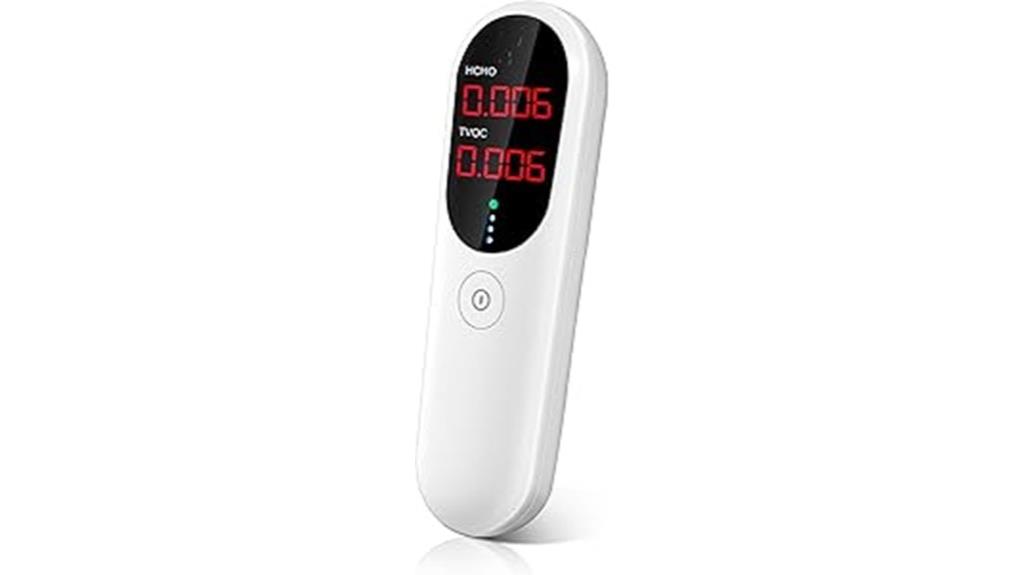
When I need to quickly assess indoor air quality, I rely on an air quality monitor equipped with highly sensitive sensors that can detect multiple pollutants simultaneously. Its compact design, one-button start, and easy calibration make it user-friendly. The large LCD display shows clear readings, and the three-color warning lights—green, yellow, and red—help me instantly understand air safety levels. It detects formaldehyde, TVOC, and other pollutants with fast, accurate measurements. Perfect for various indoor spaces, it helps me monitor air quality, identify unsafe gases, and maintain a healthier environment effortlessly.
Best For: individuals seeking an easy-to-use device for real-time indoor air quality monitoring in homes, offices, or vehicles to ensure a healthier living environment.
Pros:
- Compact and lightweight design for portability and easy handling
- Quick calibration and one-button operation simplify use for all ages
- Accurate, fast detection of multiple pollutants with clear visual alerts
Cons:
- May require regular calibration to maintain accuracy over time
- Limited to indoor environments; less effective outdoors or in large open spaces
- LCD display and warning lights provide basic info but lack detailed pollutant breakdown
Xoopon 13-in-1 Indoor Air Quality Monitor and Tester
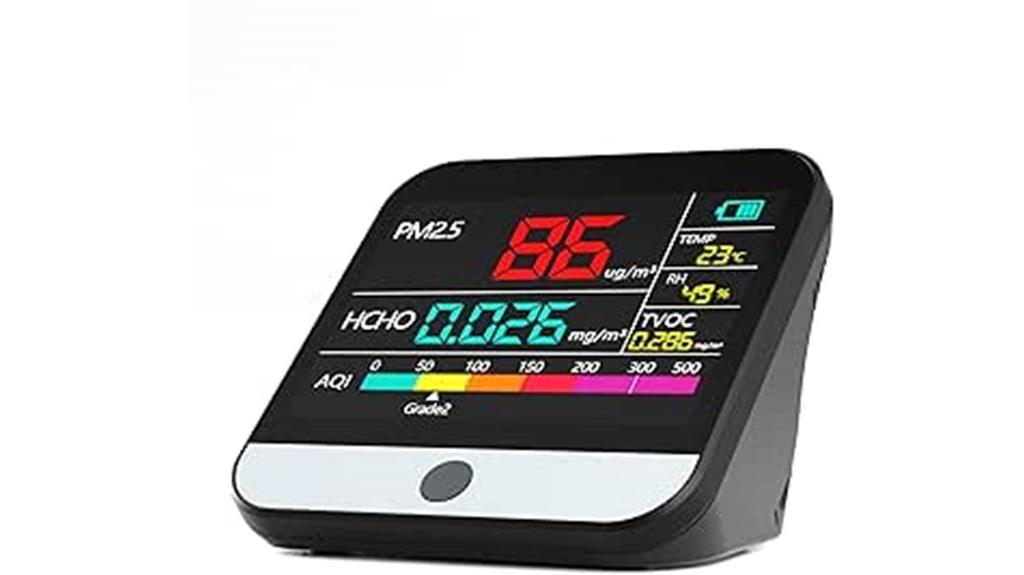
The Xoopon 13-in-1 Indoor Air Quality Monitor stands out as an ideal choice for homeowners and parents who want real-time, accurate detection of formaldehyde and other indoor pollutants. This portable device measures 13 parameters, including PM levels, TVOC, temperature, and humidity, with readings updated every 1.5 seconds. Its compact, lightweight design features a bright LCD display that clearly shows air safety levels through color coding and alerts. Powered by a rechargeable battery, it offers up to 8 hours of continuous use. With user-friendly operation and visual alarms, it’s perfect for monitoring air quality at home, in schools, or outdoors, ensuring a healthier environment.
Best For: homeowners, parents, and individuals seeking real-time, accurate indoor air quality monitoring for health and safety.
Pros:
- Provides comprehensive detection of 13 air quality parameters including PM, formaldehyde, and TVOC.
- Compact, lightweight, and easy to operate with a clear, color-coded LCD display.
- Rechargeable battery offers up to 8 hours of portable use, ideal for indoor and outdoor environments.
Cons:
- Requires approximately 200 seconds for sensor calibration before accurate readings begin.
- Limited to 8 hours of continuous operation per charge, which may necessitate frequent recharging for extended use.
- No built-in network connectivity, limiting remote monitoring capabilities.
Factors to Consider When Choosing a Formaldehyde Detector for Home Use
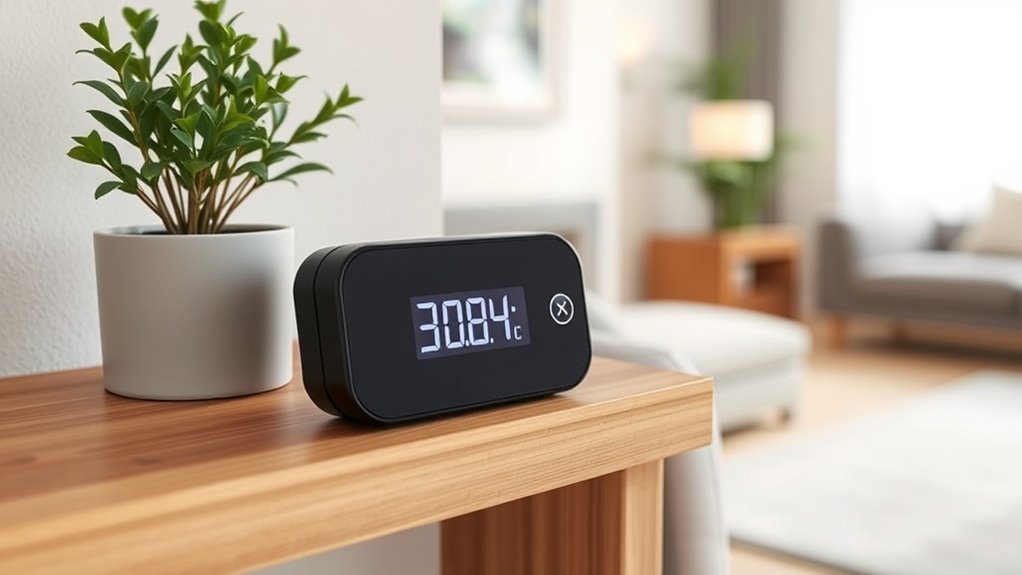
When choosing a formaldehyde detector for home use, I consider several key factors to guarantee it meets my needs. Things like measurement accuracy, sensor sensitivity, ease of use, alert systems, and portability all play a role in making the right choice. Let’s look at these points to help you find the best detector for your home.
Measurement Accuracy and Calibration
Choosing a formaldehyde detector with high measurement accuracy is essential for reliable indoor air quality assessment. Look for devices with sensors that cover typical indoor levels, like 0-5 mg/m³, and offer ±0.01 mg/m³ or better precision. Regular calibration is crucial to keep readings accurate over time; I recommend outdoor calibration in fresh air for 20-30 minutes. Devices with electrochemical sensors tend to be more reliable and stable than colorimetric or passive methods. Proper calibration often involves referencing certified standards or adjusting for temperature and humidity. Maintaining accurate measurements is indispensable because inaccurate readings can give false reassurance or cause unnecessary concern. Consistent calibration and sensor upkeep ensure your device provides trustworthy data, helping you make informed decisions about your indoor environment.
Sensor Sensitivity and Range
Selecting a formaldehyde detector involves considering its sensor sensitivity and measurement range to guarantee it fits your home’s air quality needs. Sensor sensitivity determines how small a formaldehyde concentration the device can detect, which is vital for identifying low-level emissions. The detection range indicates the minimum and maximum concentrations the sensor can accurately measure, ensuring suitability for various indoor environments. A highly sensitive sensor with a quick response time can detect sudden increases in formaldehyde levels, allowing for prompt action. Proper calibration is essential to keep readings accurate, especially near safety thresholds like 0.10 mg/m³. Sensors with broader ranges and higher sensitivity can better distinguish between safe and hazardous levels, providing more reliable indoor air quality assessments and peace of mind.
Ease of Use Features
Ease of use is crucial when picking a formaldehyde detector because it guarantees you can monitor your indoor air quality quickly and accurately without hassle. I look for devices with simple interfaces, like a single button or a clear digital display, so I can get readings fast without complicated setup. Visual alerts, such as color-coded indicators or trend graphs, help me interpret levels at a glance. Real-time data updates and easy calibration make the process straightforward and reliable. Practical features like audible alarms and vibrations notify me immediately if formaldehyde levels become unsafe. Additionally, compact, portable designs with low maintenance let me test different rooms effortlessly, ensuring my home remains healthy without wasting time or effort.
Alert Systems and Alarms
Effective alert systems are essential for ensuring I’m promptly aware of dangerous formaldehyde levels in my home. I look for detectors with loud audible alarms that activate when levels exceed safety limits, so I’m immediately informed of hazards. Visual alerts, like flashing lights or color changes, help me quickly assess air quality at a glance. Some devices even offer vibration alerts or app notifications, providing multi-sensory warnings that suit noisy or quiet environments. Adjustable alarm thresholds are useful, allowing me to customize alert levels based on health standards or personal sensitivity. Reliable detectors also feature automatic calibration and real-time monitoring, minimizing false alarms and ensuring consistent accuracy. These features give me confidence that I’ll be alerted promptly and effectively, protecting my family’s health.
Portability and Power Options
When choosing a formaldehyde detector for home use, considering its portability and power options is crucial to guarantee continuous and flexible monitoring. Portable detectors often feature rechargeable batteries, allowing use without being tethered to a power outlet, which makes them ideal for moving between rooms or outdoor checks. Many devices offer USB charging via common ports like USB-C or micro USB, providing flexible recharging options through power banks, wall adapters, or computers. Battery life varies, with some models lasting 4-5 hours and others over 20 hours, impacting their suitability for long-term or off-grid use. Compact, lightweight designs make handheld detectors easy to carry, perfect for quick spot checks or frequent relocations. Reliable power sources and ample battery capacity are essential for consistent, worry-free monitoring.
Frequently Asked Questions
How Often Should I Calibrate My Formaldehyde Detector at Home?
You’re wondering how often to calibrate your formaldehyde detector at home. I recommend calibrating it at least once every six months to guarantee accurate readings. If you notice inconsistent results or detect higher levels than expected, it’s smart to recalibrate sooner. Regular calibration keeps your detector reliable, helping you maintain a safe indoor environment. Remember, proper maintenance is key to trusting your device’s performance over time.
Are There DIY Methods to Verify My Formaldehyde Detector’S Accuracy?
Think of your formaldehyde detector as a trusted compass. While DIY methods can’t perfectly verify its accuracy, you can use a known formaldehyde source or a commercial test kit for a rough check. I recommend comparing readings with a new, calibrated detector if possible. Regular calibration remains the most reliable way to guarantee your device stays accurate, but these simple checks can give you peace of mind.
What Is the Typical Lifespan of a Formaldehyde Sensor in These Devices?
The typical lifespan of a formaldehyde sensor varies depending on the device and usage, but generally, it lasts about 2 to 3 years. I’ve found that sensors tend to become less accurate over time, so regular calibration or replacement is essential for reliable readings. Keep an eye on your device’s manufacturer recommendations, and don’t hesitate to replace the sensor when it shows signs of decreased sensitivity.
Can These Detectors Differentiate Between Formaldehyde and Other VOCS?
Imagine having a device that can subtly tell apart formaldehyde from other VOCs. While some detectors are quite advanced, most primarily measure total VOC levels, making differentiation tricky. I’ve found that high-end models with specialized sensors can distinguish formaldehyde more accurately. So, if precise identification matters to you, look for detectors with dedicated formaldehyde sensors—they’re your best bet for clear, reliable readings.
How Do Environmental Factors Affect Formaldehyde Readings Indoors?
Environmental factors definitely impact formaldehyde readings indoors. I’ve noticed that temperature and humidity can cause fluctuations; higher temperatures can release more formaldehyde from materials, while humidity can either trap or disperse it, affecting detection accuracy. Airflow also plays a role—poor ventilation may lead to higher readings, so I always consider these factors when interpreting my detector’s results. Being aware helps me maintain a safer home environment.
Conclusion
Just like a reliable compass guides you through unfamiliar terrain, choosing the right formaldehyde detector keeps your home’s air safe. I once ignored a cheap monitor, only to discover hidden formaldehyde levels that made me rethink my priorities. Investing in a trusted device is like planting a sturdy tree—providing peace of mind and a healthier environment for your loved ones. Remember, your home’s air quality isn’t just numbers; it’s your family’s well-being.
